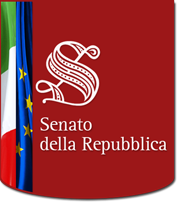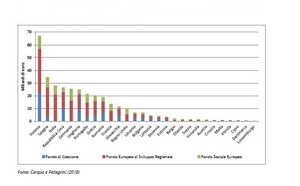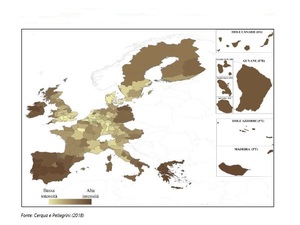Spendere per crescere? Trent’anni di interventi Ue per le aree depresse: l’impatto della coesione in Italia e in Europa

La politica di coesione dell'Unione europea rappresenta - per impegno finanziario, estensione geografica e arco temporale - uno dei più importanti programmi place-based al mondo per redistribuire la ricchezza tra regioni e Paesi e stimolare la crescita nelle aree in ritardo di sviluppo.
Con 352 miliardi di fondi strutturali da erogare nel settennio 2014-2020 - di cui 46,5 destinati all'Italia - è la politica pilastro dell'azione Ue, ma è sempre più spesso considerata dai suoi detrattori un enorme spreco di risorse, con costi elevati in termini di efficienza e di crescita economica. Anche la centralizzazione dei fondi è stata criticata - soprattutto dai Paesi con le più alte quote contributive - come dispendiosa e incoerente. Non senza qualche ragione: dopo più di trent'anni di interventi, le disparità economiche e sociali all'interno dell'Unione non sono state ancora superate, e contribuiscono anzi a indebolirne unità e stabilità.
Sulla linea di confine tra Nord e Sud, che separa i luoghi delle opportunità da quelli dell'esclusione, l'Italia si ritrova oggi con un primato non invidiabile: ha il valore più basso di sviluppo sociale nell'UE-15 e il suo Mezzogiorno, con venti milioni di abitanti, è la più grande area depressa del continente. Che cosa non ha funzionato? E quanto bisogna spendere per garantire la crescita economica alle periferie, vecchie e nuove, dell'Europa? L'UVI ha passato in rassegna le più recenti analisi d'impatto in materia di coesione. E qualche proposta per il dopo Europa2020.
Spending for Growth? Thirty Years of EU Support to Depressed Areas: the Impact of Cohesion Policy in Italy and Europe
In terms of sheer funding, geographic expanse and duration, the EU's cohesion policy is one of the leading place-based programmes in the world for the redistribution of wealth amongregions and countries and for growth support inareas where growth is lagging behind.
Although €352bn earmarked for the 2014-2020 period - of which €46,5bn are for Italy - in order to stimulate growth make cohesion policy the veritable pillar of European integration, its critics increasingly decry the policy as a huge waste of resources, witha high cost in terms of efficiency and growth. Even the centralization of funds was criticized, especially by the larger contributors, for being costly and inconsistent. Not without reason: after over thirty years of (costly) measures, economic and social imbalances within the EU have not been smoothed out: in fact, the policy has contributed to weakening unity and stability.
On the border between North and South, between opportunity and marginalisation, Italy now has the unenviable record of registering the lowest social development index in Europe at 15 and Southern Italy, with twenty million inhabitants, is the largest depressed region in Europe. What went wrong? And how much money ought to be spent in order to ensure growth in Europe's old and new periphery? Here is a review of the latest impact analysis studies on cohesion and some proposals for action after Europe 2020.







 Focus
Focus